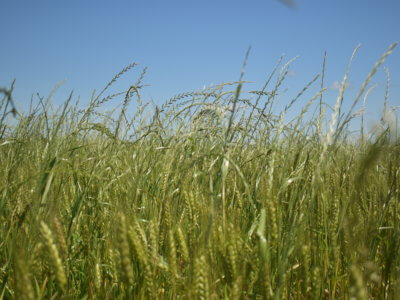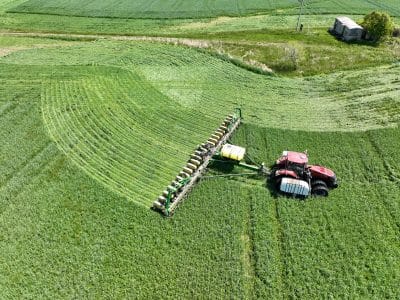Species selection of cover crops is important for weed management. Species or mixes that are vigorous and produce dense biomass generally have greater weed suppression. Additionally, various studies have found that planting a mix of species together, rather than just one, can maintain weed suppression while also incorporating other benefits such as nitrogen fixing and erosion control.
Cover crop species that grow vigorously and produce dense foliar biomass can suppress weeds more effectively than low biomass cover crops. Their dense plant canopies shade neighboring weeds and dominate resources that the weeds need to grow, such as nutrients, sunlight, and water. A recent 2017 study from Cornell University and the USDA ARS found that in warm-season grass-legume cover crop mixes (intercrops), canopy biomass was a major driver of weed suppression. Ongoing research at Penn State University also continues to show that higher biomass improves weed management by winter cover crops. Researchers at Penn State have also found cereal rye to be a stand-out option for high biomass production and effective weed suppression when used as a winter cover crop.
Biomass is not only impacted by species, but also by temperature, water, soil quality, soil nutrient availability, seeding rate, and planting and termination timing. Under good conditions for rapid growth, high biomass can be achieved with both grasses and legume species. However, the authors of the 2017 Mid-Atlantic study suggested that if weed suppression is a grower’s main goal of warm-season intercropping, a monoculture of a high-biomass grass species can achieve that most effectively at a relatively low cost compared to multi-species legume mixes.
However, growers may also choose to plant a mix of two or more species together in order to take advantage of benefits specific to certain species while maintaining weed suppression. For instance, they may incorporate a tall vigorous grass for weed suppression and a legume for soil quality purposes. The practice of planting a mix of two or more species can be referred to as intercropping.
Some studies have found groups of species that when planted together are more competitive against weeds than when planted alone. For instance, pea is not known to be highly weed suppressive; but when researchers intercropped it with barley, they found the mixture to suppress more weeds than either species did by itself. In another study in Iowa, fields that contained a mix of certain grasses and legumes suppressed weeds better than either grass-only or legume-only cover crops.
When considering cover crops, growers should consider their goals to help determine which species would be most suitable. If weed suppression is desired but other goals such as nitrogen availability and/or forage quality are highly important, they may consider combining legume and grass species to increase functionality.
In the 2017 study from the Mid-Atlantic mentioned above, the researchers tested warm-season intercrop mixes with various combinations of the following species. Here are some examples of how different species vary in growth and function:
- Pearl millet – rapidly growing cereal crop tolerant of poor soil, heat, and drought conditions. It is sometimes used to help manage soil-borne diseases and root-lesion nematodes and increase organic matter.
- Sorghum sudangrass – tall, rapidly growing cross between sorghum and sudangrass, with allelopathic qualities, that is used for weed suppression, nematode control, and to reduce soil erosion.
- Cowpea – herbaceous legume with vining, bushy, or erect growth habits used for nitrogen fixing, soil health, and attracting beneficial insects. Limited weed suppression benefit.
- Sunn hemp – tall herbaceous legume used for improved forage quality, nitrogen fixing, weed and nematode suppression.
- Cereal rye – High biomass, tall cereal crop commonly growth as a winter cover crop, with high weed suppressive potential.
For help choosing the right cover crop species or mix for your farming goals, use the Cover Crop Species Selector Tool.
The original study can be found here: http://www.bioone.org/doi/abs/10.1017/wsc.2017.25
Article by GROW staff





























































































